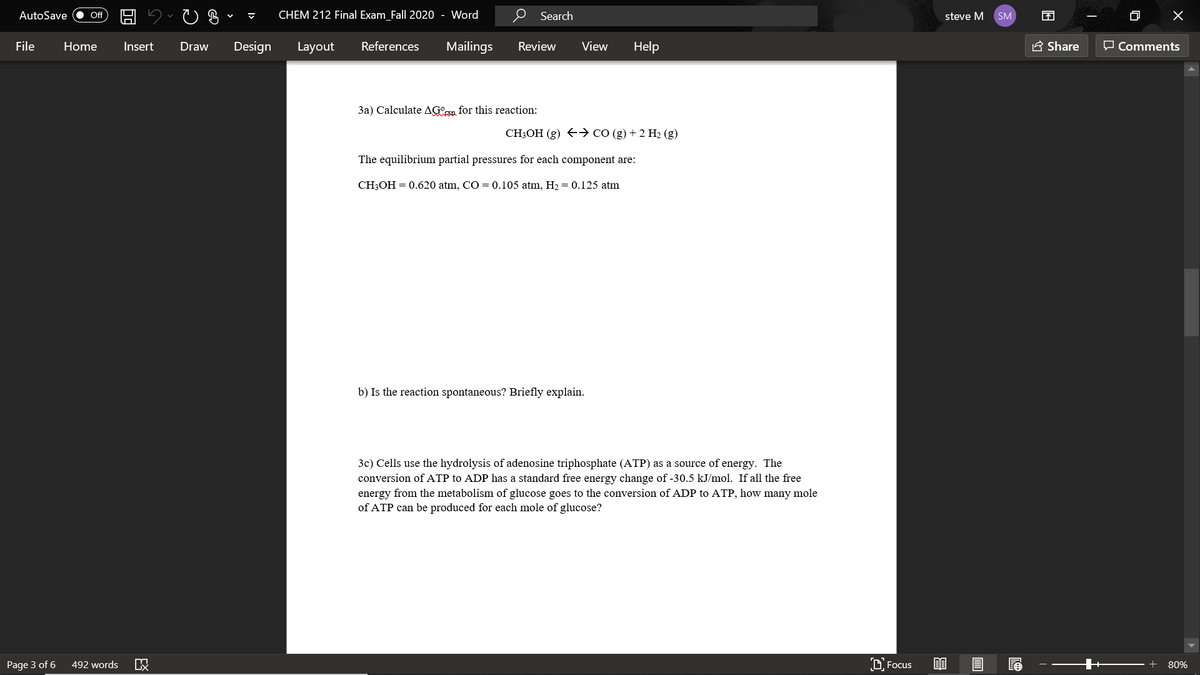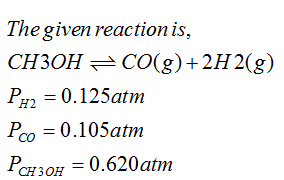3a) Calculate AG for this reaction: CH,OH (g) +→ CO (g) + 2 H; (g) The equilibrium partial pressures for each component are: CH;OH = 0.620 atm, CO = 0.105 atm, H2 = 0.125 atm
3a) Calculate AG for this reaction: CH,OH (g) +→ CO (g) + 2 H; (g) The equilibrium partial pressures for each component are: CH;OH = 0.620 atm, CO = 0.105 atm, H2 = 0.125 atm
Chemistry by OpenStax (2015-05-04)
1st Edition
ISBN:9781938168390
Author:Klaus Theopold, Richard H Langley, Paul Flowers, William R. Robinson, Mark Blaser
Publisher:Klaus Theopold, Richard H Langley, Paul Flowers, William R. Robinson, Mark Blaser
Chapter13: Fundamental Equilibrium Concepts
Section: Chapter Questions
Problem 90E: In a 3.0-L vessel, the following equilibrium partial pressures are measured: N2, 190 torr; H2, 317...
Related questions
Question

Transcribed Image Text:AutoSave
CHEM 212 Final Exam_Fall 2020
Word
Search
困
ff
steve M
SM
File
Home
Insert
Draw
Design
Layout
References
Mailings
Review
View
Help
E Share
O Comments
3a) Calculate AGon for this reaction:
CH3OH (g) → CO (g) + 2 H2 (g)
The equilibrium partial pressures for each component are:
CH;OH = 0.620 atm, CO = 0.105 atm, H2 = 0.125 atm
b) Is the reaction spontaneous? Briefly explain.
3c) Cells use the hydrolysis of adenosine triphosphate (ATP) as a source of energy. The
conversion of ATP to ADP has a standard free energy change of -30.5 kJ/mol. If all the free
energy from the metabolism of glucose goes to the conversion of ADP to ATP, how many mole
of ATP can be produced for each mole of glucose?
Page 3 of 6
492 words
D Focus
80%
Expert Solution
Step 1

Step 2

Step by step
Solved in 3 steps with 3 images

Knowledge Booster
Learn more about
Need a deep-dive on the concept behind this application? Look no further. Learn more about this topic, chemistry and related others by exploring similar questions and additional content below.Recommended textbooks for you

Chemistry by OpenStax (2015-05-04)
Chemistry
ISBN:
9781938168390
Author:
Klaus Theopold, Richard H Langley, Paul Flowers, William R. Robinson, Mark Blaser
Publisher:
OpenStax

Chemistry for Engineering Students
Chemistry
ISBN:
9781337398909
Author:
Lawrence S. Brown, Tom Holme
Publisher:
Cengage Learning

Chemistry & Chemical Reactivity
Chemistry
ISBN:
9781133949640
Author:
John C. Kotz, Paul M. Treichel, John Townsend, David Treichel
Publisher:
Cengage Learning

Chemistry by OpenStax (2015-05-04)
Chemistry
ISBN:
9781938168390
Author:
Klaus Theopold, Richard H Langley, Paul Flowers, William R. Robinson, Mark Blaser
Publisher:
OpenStax

Chemistry for Engineering Students
Chemistry
ISBN:
9781337398909
Author:
Lawrence S. Brown, Tom Holme
Publisher:
Cengage Learning

Chemistry & Chemical Reactivity
Chemistry
ISBN:
9781133949640
Author:
John C. Kotz, Paul M. Treichel, John Townsend, David Treichel
Publisher:
Cengage Learning

Chemistry & Chemical Reactivity
Chemistry
ISBN:
9781337399074
Author:
John C. Kotz, Paul M. Treichel, John Townsend, David Treichel
Publisher:
Cengage Learning

Chemistry: The Molecular Science
Chemistry
ISBN:
9781285199047
Author:
John W. Moore, Conrad L. Stanitski
Publisher:
Cengage Learning

Chemistry: Principles and Reactions
Chemistry
ISBN:
9781305079373
Author:
William L. Masterton, Cecile N. Hurley
Publisher:
Cengage Learning